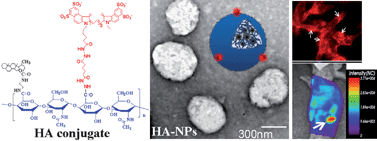Self-assembled hyaluronic acidnanoparticles as a potential drug carrier for cancer therapy: synthesis, characterization, and in vivo biodistribution
Abstract
To develop a nano-sized

* Corresponding authors
a Biomedical Research Center, Korea Institute of Science and Technology, Seoul, South Korea
b Department of Life and Nanopharmaceutical Sciences, Kyung Hee University, Seoul, South Korea
c Department of Advanced Polymer and Fiber Materials, Kyung Hee University, Gyeonggi-do, South Korea
To develop a nano-sized

 Please wait while we load your content...
Something went wrong. Try again?
Please wait while we load your content...
Something went wrong. Try again?
K. Y. Choi, K. H. Min, J. H. Na, K. Choi, K. Kim, J. H. Park, I. C. Kwon and S. Y. Jeong, J. Mater. Chem., 2009, 19, 4102 DOI: 10.1039/B900456D
To request permission to reproduce material from this article, please go to the Copyright Clearance Center request page.
If you are an author contributing to an RSC publication, you do not need to request permission provided correct acknowledgement is given.
If you are the author of this article, you do not need to request permission to reproduce figures and diagrams provided correct acknowledgement is given. If you want to reproduce the whole article in a third-party publication (excluding your thesis/dissertation for which permission is not required) please go to the Copyright Clearance Center request page.
Read more about how to correctly acknowledge RSC content.
 Fetching data from CrossRef.
Fetching data from CrossRef.
This may take some time to load.
Loading related content
